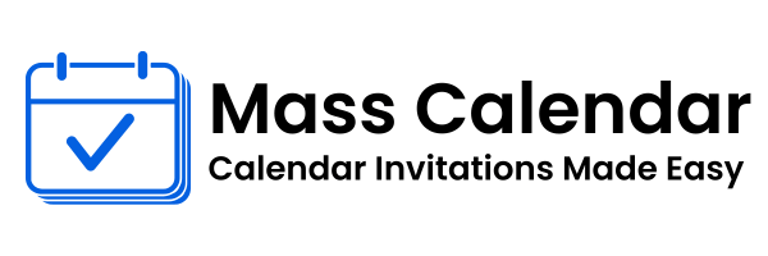Streamlining Large-Scale Scheduling: A Practical Roadmap for Modern Teams
Coordinating one-to-one meetings is simple: check calendars, propose a slot, and send a confirmation. Coordinating hundreds of busy professionals across regions, time-zones, and devices is another story entirely. Successful organizers know that to send mass calendar invites effectively, they must combine airtight preparation with clear communication and smart follow-up. This guide breaks the process into manageable steps so your next large-scale session lands smoothly and garners high attendance.
BLOG
6/23/20252 min read


Coordinating one-to-one meetings is simple: check calendars, propose a slot, and send a confirmation. Coordinating hundreds of busy professionals across regions, time-zones, and devices is another story entirely. Successful organizers know that to send mass calendar invites effectively, they must combine airtight preparation with clear communication and smart follow-up. This guide breaks the process into manageable steps so your next large-scale session lands smoothly and garners high attendance.
1. Clarify the Objective Before Touching a Calendar
Define the “Why.” Is this a project kickoff, a quarterly town hall, or a community webinar?
Identify Stakeholders. Who must attend, who should attend, and who needs only a summary?
Set Success Metrics. Is your target 90 % live participation or 100 % on-demand playback? Decide early so you can design reminders and post-event actions accordingly.
2. Choose the Right Send Window
Time-Zone Equity. Run proposed slots through a world clock; aim for overlap in core working hours.
Avoid Local Holidays. Check regional calendars to sidestep dates like Diwali or Thanksgiving.
Give Adequate Lead Time. For an all-hands, three to four weeks’ notice boosts acceptance rates.
3. Craft a Crystal-Clear Invitation
Subject Line: Place the date and descriptive title up front: “Global R&D Sync — 14 Oct 2025.”
Body Copy: Summarize the purpose in one sentence, then list agenda bullets.
Attachments & Links: Host slide decks or resources in the cloud to avoid bloated file sizes.
Accessibility: Include dial-in numbers and captions settings for colleagues on slow connections.
When you send mass meeting invites, these details show respect for your recipients’ time and bandwidth.
4. Platform-Agnostic Best Practices
ICS Compatibility. Always attach a universal .ics file for fringe clients.
One-Click Entry. Embed direct video links rather than portal URLs that require extra navigation.
Self-Updating Agendas. Link to a living document so late edits appear without a second send.
Even if you eventually send bulk meeting invite in Gmail or schedule through another service, these neutral assets keep the experience consistent for every attendee.
5. Test Twice, Send Once
Internal Dress Rehearsal. Invite two colleagues on different domains and devices; confirm correct local times.
External Preview. Send to a personal account viewed on desktop and mobile to check formatting.
Catching a misaligned time-zone or broken attachment before thousands receive the invite preserves your credibility.
6. Launch Strategy
Batch Large Lists. SMTP caps can throttle delivery; split lists above 500 addresses into timed waves.
Track RSVPs Daily. Acceptance trends guide reminder cadence and help identify blockers early.
Respect Privacy. Use personalized messages or BCC fields to avoid exposing distribution lists.
Executing these steps properly ensures you send mass calendar invites that reach inboxes rather than junk folders.
7. Managing Changes Without Chaos
Plans shift. Mitigate confusion by editing the original event rather than firing off new ones. Prefix updates with “UPDATED:” and include a brief summary of what changed—date, time, or link. A concise follow-up email reinforces the update for stakeholders who may rely on inbox notifications more than calendar pop-ups.
8. Day-Of Execution
Open the Room Early. Whether virtual or physical, unlock the environment 10 minutes ahead.
Monitor Live Attendance. Note late joiners and connectivity issues for future improvement.
Record and Archive. Store the session in an accessible library for colleagues in distant time-zones.
9. Post-Event Wrap-Up
Send a Summary. Bullet decisions and next steps within 24 hours.
Update Recurring Series. Delete or reschedule future instances you no longer need.
Analyze Metrics. Compare acceptance vs. attendance to refine your next mass meeting invites strategy.
Conclusion
Large-scale scheduling looks daunting until you systematize each phase: define purpose, clean data, draft a transparent invite, test rigorously, and monitor responses. By treating calendaring as a repeatable process rather than a one-off scramble, you’ll deliver seamless experiences for attendees and free yourself to focus on the meeting content that truly matters.
MassCalendar.in
Send Bulk & Mass Calendar Invites Instantly
CONTACT
Meetings
+44 (0) 203 916 5117
© 2025. All rights reserved.
Help?
